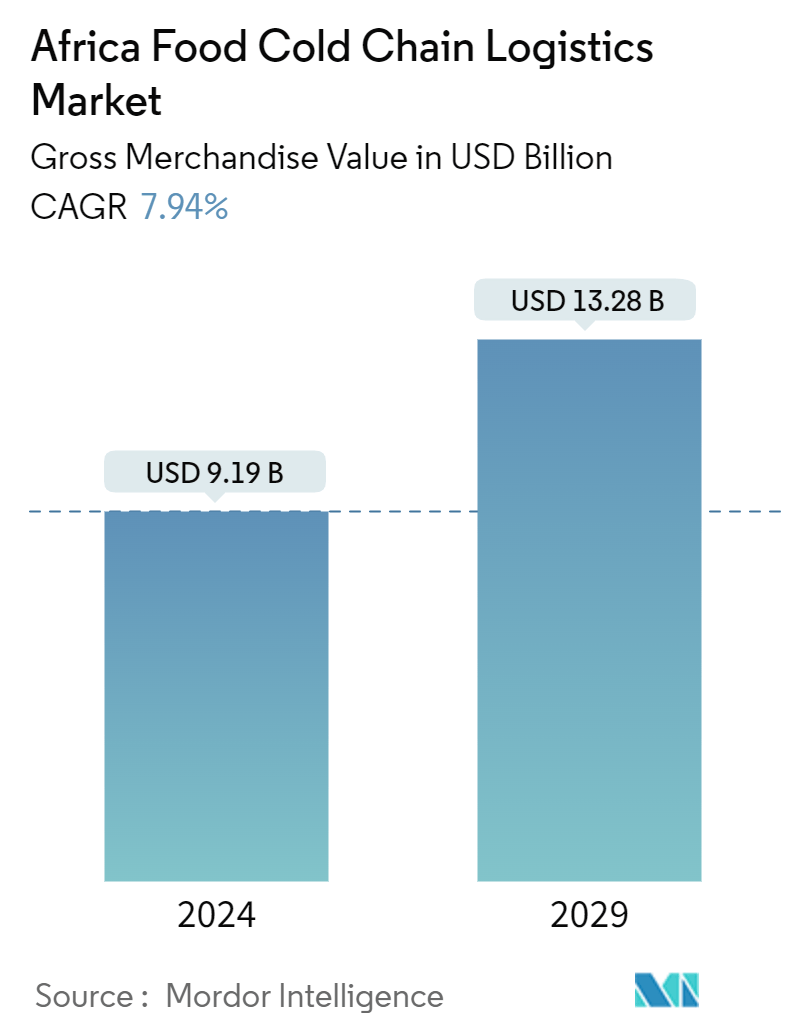Market Size of Africa Food Cold Chain Logistics Industry

| Study Period | 2020 - 2029 |
| Base Year For Estimation | 2023 |
| Market Size (2024) | USD 9.19 Billion |
| Market Size (2029) | USD 13.28 Billion |
| CAGR (2024 - 2029) | 7.94 % |
| Market Concentration | Low |
Major Players
*Disclaimer: Major Players sorted in no particular order |
Africa Food Cold Chain Logistics Market Analysis
The Africa Food Cold Chain Logistics Market size in terms of gross merchandise value is expected to grow from USD 9.19 billion in 2024 to USD 13.28 billion by 2029, at a CAGR of 7.94% during the forecast period (2024-2029).
Changes in lifestyle and urbanization contributing to increased domestic consumption of processed foods and a shift in consumption patterns, including increased consumption of fresh fruits, as people become more health concerned, need to address food wastage and ensure food security, are the factors assisting the market's growth.
The climate change crisis has significantly contributed to the dire food insecurity and food wastage in Africa. Over one-third of food produced in Africa is estimated to be lost to spoilage or waste. The United Nations Food and Agriculture Organization estimates that over 40% of food in Sub-Saharan Africa perishes before it reaches a consumer. This can be as high as 60% for fresh produce in Sub-Saharan Africa.
The leading cause of food wastage is spoilage due to the lack of cold storage facilities to extend the shelf life, especially temperature-sensitive food items. Farmers and agri-traders in Africa rely on makeshift coolers or outdated, generic cold rooms. These systems are unreliable, poorly maintained, and have high operational costs.
Cold storage or cold supply chain products can help reduce spoilage and maintain quality and efficacy, but they require sufficient electricity to work effectively. In Africa, according to the African Development Bank (AfDB), electricity is out of reach for more than 640 million people, and the ability to sustainably maintain constant cold temperatures remains a challenge. There is an urgent need to deploy resilient, reliable, and sustainable cold chains to tackle food and medicine losses in Africa.
Several startups in Africa are innovating digital solutions to respond to emerging challenges. These startups offer cold storage products and solutions that are energy-efficient and compliant with export standards. They are also affordable and well-equipped with temperature and performance monitoring systems.
According to a Cold Chain Storage industry report, the cold chain infrastructure is developing in East Africa, with cold chain infrastructure in Southern Africa being more developed and geared toward exporters.
Africa Food Cold Chain Logistics Industry Segmentation
A cold chain is a temperature-controlled supply chain. Cold chain logistics is a technology and process that enables the safe transportation of temperature-sensitive goods and products along the supply chain. The market size captures the revenue accrued by the logistics companies by providing services such as transportation, storage, and other value-added services. The current market report scope captures only cold chain logistics spending related to food cold chain and does not include other products such as pharmaceuticals and chemicals.
The African food cold chain logistics market is segmented by service (storage, transportation, and value-added services), temperature (chilled, frozen, and ambient), product category (horticulture, dairy products, meat, poultry, and seafood, processed food products, and other categories), and country (Egypt, Nigeria, South Africa, and other countries). The report offers market size and forecast in value (USD) for all the above segments.
| By Service | |
| Storage | |
| Transportation | |
| Value-added Services (Blast Freezing, Labeling, Inventory Management, etc.) |
| By Temperature | |
| Chilled | |
| Frozen | |
| Ambient |
| By Product Category | |
| Horticulture (Fresh Fruits and Vegetables) | |
| Dairy Products (Milk, Ice Cream, Butter, etc.) | |
| Meat, Poultry, and Seafood | |
| Processed Food Products | |
| Other Categories |
| By Country | |
| Egypt | |
| Nigeria | |
| South Africa | |
| Other Countries |
Africa Food Cold Chain Logistics Market Size Summary
The Africa Food Cold Chain Logistics Market is poised for significant growth, driven by changing consumer lifestyles and urbanization, which have led to increased domestic consumption of processed foods and fresh produce. This shift is partly due to heightened health consciousness and the need to address food wastage and ensure food security. The region faces substantial challenges, including the impact of climate change, which exacerbates food insecurity and wastage, with a significant portion of food produced in Africa lost to spoilage. The lack of adequate cold storage facilities, particularly for temperature-sensitive items, is a major contributor to this issue. Despite these challenges, there is a burgeoning demand for resilient and sustainable cold chain solutions, with startups innovating energy-efficient and export-compliant cold storage products.
South Africa and Egypt play pivotal roles in the African food cold chain logistics market, with South Africa hosting a significant portion of the continent's cold storage capacity and Egypt being a leading exporter of fruits and vegetables. However, South Africa's energy crisis, characterized by frequent power cuts, poses a significant challenge to maintaining cold chain integrity, particularly for fresh produce. The South African fruit industry is a major contributor to the country's agricultural exports, with a strategic focus on retaining traditional markets and expanding into new regions. Regional logistics providers are crucial in navigating the diverse African market, offering integrated cold chain services that are essential for preserving temperature-sensitive products. Recent expansions in cold storage facilities, such as those by Africa Global Logistics in Côte d'Ivoire and Cold Solutions Kenya, highlight the ongoing development and investment in cold chain infrastructure across the continent.
Africa Food Cold Chain Logistics Market Size - Table of Contents
-
1. MARKET INSIGHTS
-
1.1 Market Overview
-
1.2 Value Chain/Supply Chain Analysis
-
1.3 Government Regulations and Initiatives in the Industry
-
1.4 Technological Developments in the Market
-
1.5 Insights on Innovative Startups in the Market (Solar Freeze, InspiraFarms, Coldbox Store, ColdHubs, and Freezelink)
-
1.6 Impact of the COVID - 19 Pandemic on the Market
-
-
2. MARKET SEGMENTATION
-
2.1 By Service
-
2.1.1 Storage
-
2.1.2 Transportation
-
2.1.3 Value-added Services (Blast Freezing, Labeling, Inventory Management, etc.)
-
-
2.2 By Temperature
-
2.2.1 Chilled
-
2.2.2 Frozen
-
2.2.3 Ambient
-
-
2.3 By Product Category
-
2.3.1 Horticulture (Fresh Fruits and Vegetables)
-
2.3.2 Dairy Products (Milk, Ice Cream, Butter, etc.)
-
2.3.3 Meat, Poultry, and Seafood
-
2.3.4 Processed Food Products
-
2.3.5 Other Categories
-
-
2.4 By Country
-
2.4.1 Egypt
-
2.4.2 Nigeria
-
2.4.3 South Africa
-
2.4.4 Other Countries
-
-
Africa Food Cold Chain Logistics Market Size FAQs
How big is the Africa Food Cold Chain Logistics Market?
The Africa Food Cold Chain Logistics Market size is expected to reach USD 9.19 billion in 2024 and grow at a CAGR of 7.94% to reach USD 13.28 billion by 2029.
What is the current Africa Food Cold Chain Logistics Market size?
In 2024, the Africa Food Cold Chain Logistics Market size is expected to reach USD 9.19 billion.

